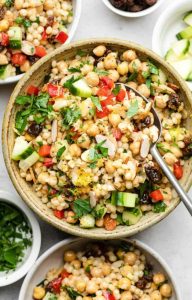Mediterranean Couscous Salad: A Flavorful, Healthy Delight
Mediterranean cuisine is renowned for its fresh flavors and health benefits, making it a popular choice for those looking to eat well without sacrificing taste. One of the standout dishes is the Mediterranean Couscous Salad, a versatile and nutritious option that can be enjoyed as a main dish or a side. This salad combines couscous with fresh vegetables, herbs, and a zesty dressing, perfectly capturing the essence of Mediterranean cooking.
In this article, we’ll take a deep dive into making a Mediterranean Couscous Salad, from choosing the right type of couscous to adding the perfect mix of ingredients. Plus, we’ll explore some variations, meal prep tips, and frequently asked questions to ensure you have all the information you need to create this delicious dish.

Types of Couscous Used in Mediterranean Salads
When crafting the perfect Mediterranean Couscous Salad, the type of couscous you use is crucial. The two main types you’ll encounter are:
- Traditional Couscous: This tiny, grain-like pasta made from semolina wheat is light and fluffy, cooking up quickly and effortlessly.
- Israeli Couscous (Pearl Couscous): Larger and rounder, this type has a chewier texture that adds a satisfying bite to salads.
Each type of couscous offers unique textures and flavors, so your choice depends on the salad’s desired final texture. For a light and airy dish, go with traditional couscous, while Israeli couscous is ideal for a heartier, more filling salad.
For a deeper understanding of olive oil’s nutritional benefits, which is a key ingredient in many Mediterranean dishes, see Benefits of Olive Oil.
Key Ingredients in a Mediterranean Couscous Salad
The beauty of a Mediterranean Couscous Salad lies in the harmonious blend of simple, fresh ingredients. Here’s what you’ll need:
- Couscous: Whether traditional or Israeli, this forms the salad’s base.
- Vegetables: Fresh, crunchy vegetables like tomatoes, cucumbers, bell peppers, and red onions add color and texture.
- Herbs: Fresh herbs such as parsley, mint, and cilantro provide a burst of freshness. Learn more about the importance of herbs in Mediterranean cooking here.
- Proteins: Additions like chickpeas, feta cheese, or grilled chicken can make the salad more substantial.
- Dressings: A simple combination of olive oil, lemon juice, and a touch of balsamic vinegar ties all the flavors together.
- Add-ons: Enhance the salad with olives, sun-dried tomatoes, or nuts for extra flavor and texture.
For those who enjoy Mediterranean flavors, you might also love this Pasta alla Norma recipe, which showcases another delicious combination of ingredients.
Step-by-Step Guide to Making a Classic Mediterranean Couscous Salad
Cooking the Couscous
- Boil Water: Use 1 1/2 cups of water for every cup of couscous.
- Add Couscous: Stir in the couscous, cover, and remove from heat. Let it steam for 5 minutes.
- Fluff: Fluff the couscous with a fork before adding it to your salad.
Preparing Vegetables and Proteins
- Chop Vegetables: Dice the tomatoes, cucumbers, and other vegetables into bite-sized pieces.
- Cook Proteins: If using chicken or shrimp, grill them until fully cooked, then slice or chop as needed.
Assembling the Salad
- Combine Ingredients: In a large bowl, mix the couscous, vegetables, and proteins.
- Add Dressing: Drizzle with olive oil, lemon juice, and balsamic vinegar. Toss to coat evenly.
- Season: Season with salt, pepper, and any other preferred spices.
Variations of Mediterranean Couscous Salad
- Vegetarian: Skip the meat and add extra chickpeas or tofu for protein.
- Protein-Packed: Include grilled chicken, shrimp, or tuna for a more filling salad.
- Gluten-Free: Substitute couscous with quinoa or a gluten-free couscous variety.
- Spicy Variation: Add harissa or chili flakes for a spicy kick.
Meal Prep and Storage Tips
- Prepare in Advance: You can make the salad ahead of time and store it in the fridge for up to 3 days.
- Storage: Keep the salad in an airtight container to maintain freshness.
- Refreshing: Before serving, toss the salad with some fresh lemon juice to revive the flavors.
Serving Suggestions and Pairings
Mediterranean Couscous Salad pairs beautifully with various dishes and drinks:
- Main Courses: Serve alongside grilled fish, chicken, or lamb.
- Drinks: Pair with a crisp white wine or sparkling water with a lemon twist.
- Occasions: Perfect for picnics, potlucks, or as a side dish at a Mediterranean-themed dinner.
For a refreshing accompaniment, consider serving it with this Avocado Salsa, which adds a creamy, tangy contrast to the couscous salad.
FAQs About Mediterranean Couscous Salad
What is the difference between Israeli and regular couscous?
- Israeli couscous is larger and has a chewier texture compared to the smaller, fluffier traditional couscous.
Can you eat couscous salad cold?
- Yes, couscous salad is delicious served cold, making it perfect for picnics or meal prep.
How long does Mediterranean couscous salad last?
- It can last up to 3 days in the fridge if stored properly in an airtight container.
Is couscous healthier than rice?
- Couscous is lower in calories and carbohydrates compared to rice, making it a healthier choice for some.
What can I substitute for couscous?
- Quinoa or bulgur are great substitutes if you’re looking for a gluten-free or different textured option.
